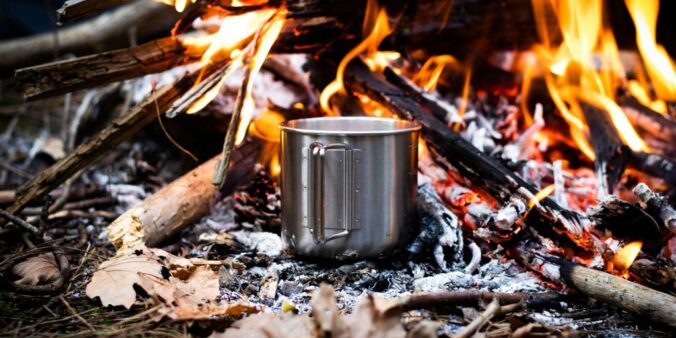Enjoying a well-cooked meal in the great outdoors is one of the highlights of any camping trip. But to make great-tasting food while camping, you need two pieces of special equipment: a good camp stove and a good set of camp cookware. Trying to cook with cheap, gimmicky camp pots and pans can be frustrating, and dragging out your expensive home cookware risks damaging it. That is why we recommend picking up a few dedicated pieces of cookware that you use specifically for camping.
Key Takeaways
- Investing in quality camping cookware enhances your outdoor cooking experience and allows for a wider range of meal options.
- Consider the type of camp stove and fuel options to ensure compatibility and ease of use during your camping trips.
- Opt for versatile, durable, and easy-to-clean pots and pans to make meal preparation and cleanup more efficient.
- Non-stick cookware can significantly reduce cleaning time and improve cooking efficiency in a camp setting.
- Compact and lightweight cookware is essential for backpacking, offering space-saving solutions without compromising functionality.
Choosing the Right Camp Stove
Selecting the perfect camp stove is crucial for any outdoor cooking adventure. A good camp stove can make all the difference in your camping culinary experience, ensuring you can prepare delicious meals efficiently and safely.
Must-Have Pots and Pans for Camping

Setting up a camp kitchen with the right pots and pans can make all the difference in your outdoor culinary adventures. Choosing the right cookware ensures you can prepare gourmet meals even in the wilderness. Here are some essential considerations for selecting the best pots and pans for camping life.
Material Options
When it comes to camping gear, the material of your pots and pans is crucial. Common options include:
- Aluminum: Lightweight and affordable, but can dent easily.
- Stainless Steel: Durable and resistant to scratches, though heavier.
- Titanium: Extremely light and strong, but often more expensive.
Size and Weight
Consider the size and weight of your cookware, especially if you’re backpacking. A good rule of thumb is to have a large skillet and a pot with a lid. This setup is versatile enough for most campers and can handle a variety of meals.
Versatility
Versatile cookware can enhance your camping experience. Look for pots and pans that can be used over a campfire, on a portable grill, or even on a camp stove. Multi-use items save space and weight, making them ideal for camping hacks.
With the right pots and pans, you can enhance outdoor culinary skills and enjoy memorable camping adventures.
Investing in quality camping cookware is a game-changer. It not only makes cooking easier but also adds to the overall enjoyment of your camping trips. Happy cooking, campers!
Essential Cooking Utensils for the Camp Kitchen

When it comes to setting up your camp kitchen, having the right cooking utensils can make all the difference. Dedicated camping kitchen utensils are a must-have to ensure you don’t forget any critical items. Here’s a breakdown of the essential tools you’ll need for a successful outdoor cooking experience.
Benefits of Non-Stick Camping Cookware
Ease of Cleaning
One of the standout benefits of non-stick camping cookware is how easy it is to clean. In the field, where water might be scarce, non-stick pots and pans require minimal water and effort to get spotless. This convenience can make a big difference after a long day of outdoor activities.
Cooking Efficiency
Non-stick surfaces allow for even heat distribution, which means your food cooks more efficiently. This can be particularly useful when you’re trying to prepare meals quickly. Additionally, non-stick cookware often requires less oil or butter, making your meals healthier.
Durability
While non-stick coatings can wear out quicker than other materials, you can extend their life by using soft utensils and cooking on medium heat. This makes them a practical choice for many campers. Durability is an important criterion when selecting camping cookware, and with proper care, non-stick options can serve you well for years.
Non-stick camping cookware offers a blend of convenience and efficiency that can significantly enhance your outdoor cooking experience.
Cookware for Open-Flame Cooking
Cooking over an open flame is a quintessential camping experience that brings out unique flavors in your meals. When selecting cookware for this purpose, it’s important to choose items that can withstand high heat and direct flames. Avoid cookware with plastic components that could melt or get damaged.
Cast Iron Options
Cast iron is a popular choice for open-flame cooking due to its durability and heat retention. The Lodge Dutch Oven Combo Cooker, for example, is highly versatile and can be used as a deep skillet or a frying pan. However, keep in mind that cast iron cookware can be quite heavy, which might be a consideration if you’re looking for portability.
Safety Tips
- Always use heat-resistant gloves when handling hot cookware.
- Ensure your cooking area is stable to prevent accidents.
- Keep a bucket of water or a fire extinguisher nearby for emergencies.
Cooking over an open flame requires a bit of practice, but the results are well worth the effort.
Popular Recipes
Open-flame cooking opens up a world of culinary possibilities. Here are a few popular recipes to try:
- Campfire Stew: A hearty mix of meat, potatoes, and vegetables cooked slowly over the fire.
- Grilled Fish: Freshly caught fish seasoned and grilled to perfection.
- S’mores: The classic camping dessert made with graham crackers, chocolate, and marshmallows.
For more detailed guides on top camping stoves and cookware, check out [the best camping stoves for cooking delicious meals outdoors](pathname: /camping-stove/).
Compact and Lightweight Cookware for Backpacking

When you’re heading into the backcountry, choosing the right cookware can make all the difference. Compact and lightweight options are essential for backpacking, ensuring you can carry everything you need without being weighed down.
Stackable Sets
Stackable cookware sets are a great way to save space in your backpack. These sets often include pots, pans, and lids that nest within each other, making them easy to pack and carry. Popular options include the GSI Pinnacle Dualist HS, which is both lightweight and versatile, perfect for short backpacking trips.
Multi-Use Items
Opt for multi-use items to maximize functionality while minimizing weight. For example, a pot that doubles as a bowl or a lid that can be used as a frying pan can significantly reduce the amount of gear you need to bring. The MSR Fusion Ceramic is a great example of a compact set that provides the foundation for your backpacking kitchen.
Space-Saving Tips
- Choose ultralight materials: Look for cookware made from aluminum or titanium, which are both durable and lightweight.
- Opt for integrated systems: All-in-one cooking systems, like the Jetboil Flash, offer the lightest and most compact options, perfect for minimalist hikers.
- Pack smart: Use stuff sacks that double as wash basins to save space and add functionality.
When every ounce counts, integrated cooking systems offer the lightest and most compact options, making them ideal for backpacking trips.
By selecting the right compact and lightweight cookware, you can enjoy gourmet meals even in the most remote locations.
Cookware Maintenance and Care Tips

Cleaning Techniques
Proper cleaning is essential to extend the life of your camping cookware. Be cautious with how you scrub your pans; using the wrong brush can ruin your set. Stainless steel can handle abrasive steel wool pads, but for aluminum and titanium sets, green scrubbing pads are the best option. For non-stick cookware, use soft utensils to avoid scratching the coating and always cook on medium heat.
Storage Solutions
When it comes to storing your cookware, prioritize durability. Look for nesting designs or protective casings that shield more vulnerable items, like ceramic pots and pans, from abrasions and damage during transit. This will help keep your cookware in top shape for many camping trips to come.
Longevity Tips
To ensure your cookware lasts, consider the material. Stainless steel and cast iron are known for their scratch resistance and durability. With cast iron, it’s essential to wash, dry, and regularly coat with oil to extend its life. Additionally, avoid using metal utensils on non-stick coatings to prevent damage.
Taking good care of your camping cookware not only extends its life but also enhances your overall camping experience by ensuring you always have reliable tools at hand.
Proper maintenance and care of your cookware can significantly extend its lifespan and enhance your cooking experience. From cleaning tips to storage solutions, our comprehensive guide covers everything you need to know. For more detailed tips and expert advice, visit our website and ensure your cookware stays in top condition for years to come.
Conclusion
Cooking gourmet meals while camping is not only possible but also incredibly rewarding with the right equipment. Investing in quality camping cookware tailored to your needs can make all the difference in your outdoor culinary adventures. From versatile Dutch ovens to compact, stackable sets, there’s a wide range of options to suit every camper’s style and preferences. Remember, the key to a successful camp kitchen is having durable, easy-to-clean, and efficient cookware. So, gear up, head out, and enjoy the delicious possibilities that await you in the great outdoors!
Frequently Asked Questions
Why should I invest in dedicated camping cookware?
Using dedicated camping cookware ensures that you have durable, lightweight, and easy-to-clean equipment specifically designed for outdoor use. It also protects your home cookware from potential damage.
What is the best type of camp stove for gourmet meals?
The best type of camp stove for gourmet meals depends on your specific needs, but many campers prefer multi-burner stoves for their versatility and ability to cook multiple dishes simultaneously.
Are non-stick pans good for camping?
Yes, non-stick pans are excellent for camping as they make cooking and cleaning up much easier. Just be sure to handle them carefully to avoid scratching the surface.
How do I choose the right size of pots and pans for camping?
Consider the number of people you’ll be cooking for and the types of meals you plan to prepare. Smaller, lightweight pots are ideal for backpacking, while larger pots and pans are better for car camping and group meals.
What materials are best for camping cookware?
Common materials for camping cookware include aluminum, stainless steel, and cast iron. Aluminum is lightweight and affordable, stainless steel is durable and resistant to corrosion, and cast iron offers excellent heat retention and versatility.
How do I maintain and care for my camping cookware?
To maintain your camping cookware, clean it thoroughly after each use, store it in a dry place, and follow any specific care instructions provided by the manufacturer. For cast iron, make sure to season it regularly to prevent rust.


Leave a Reply